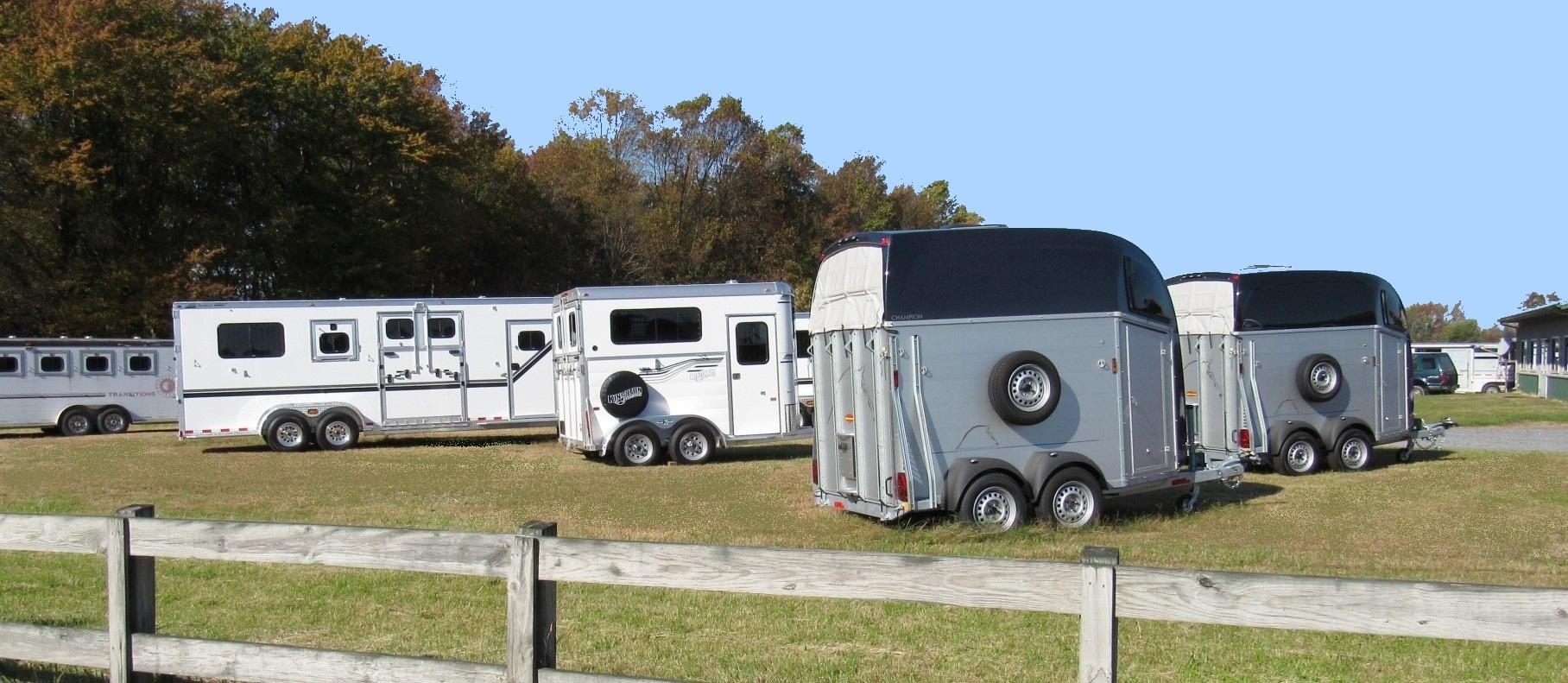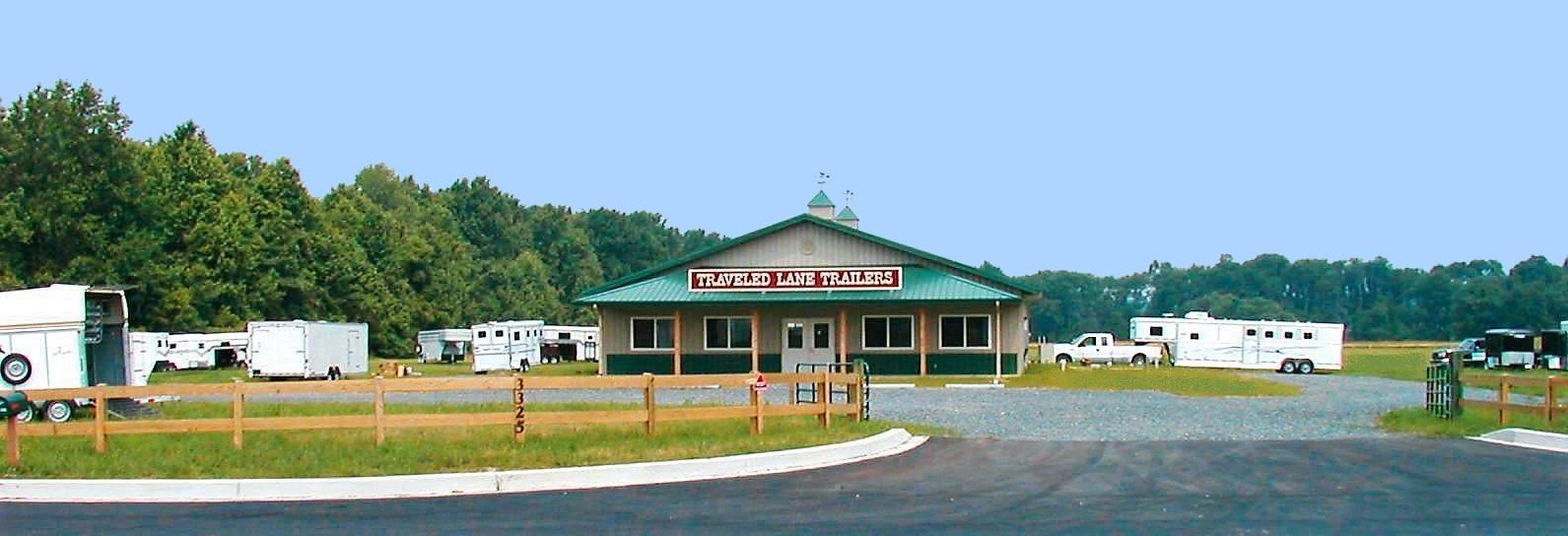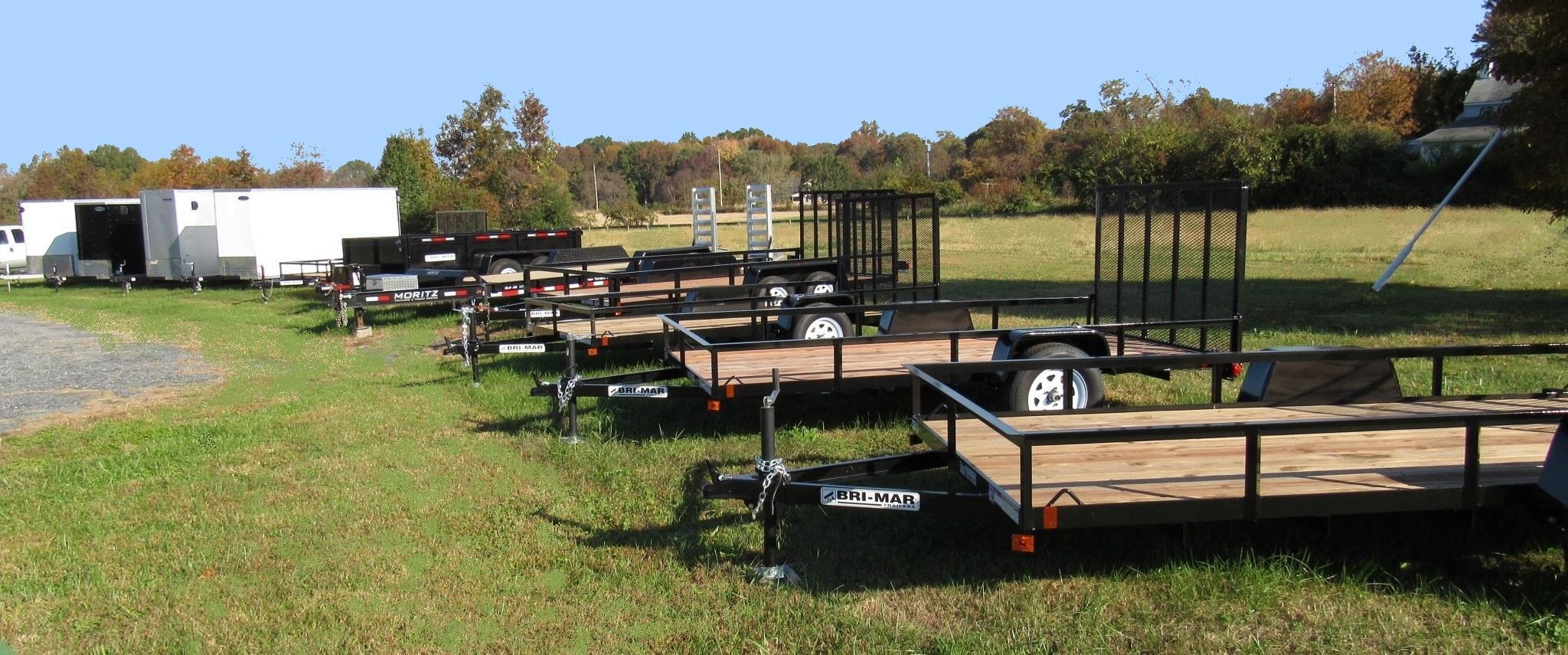
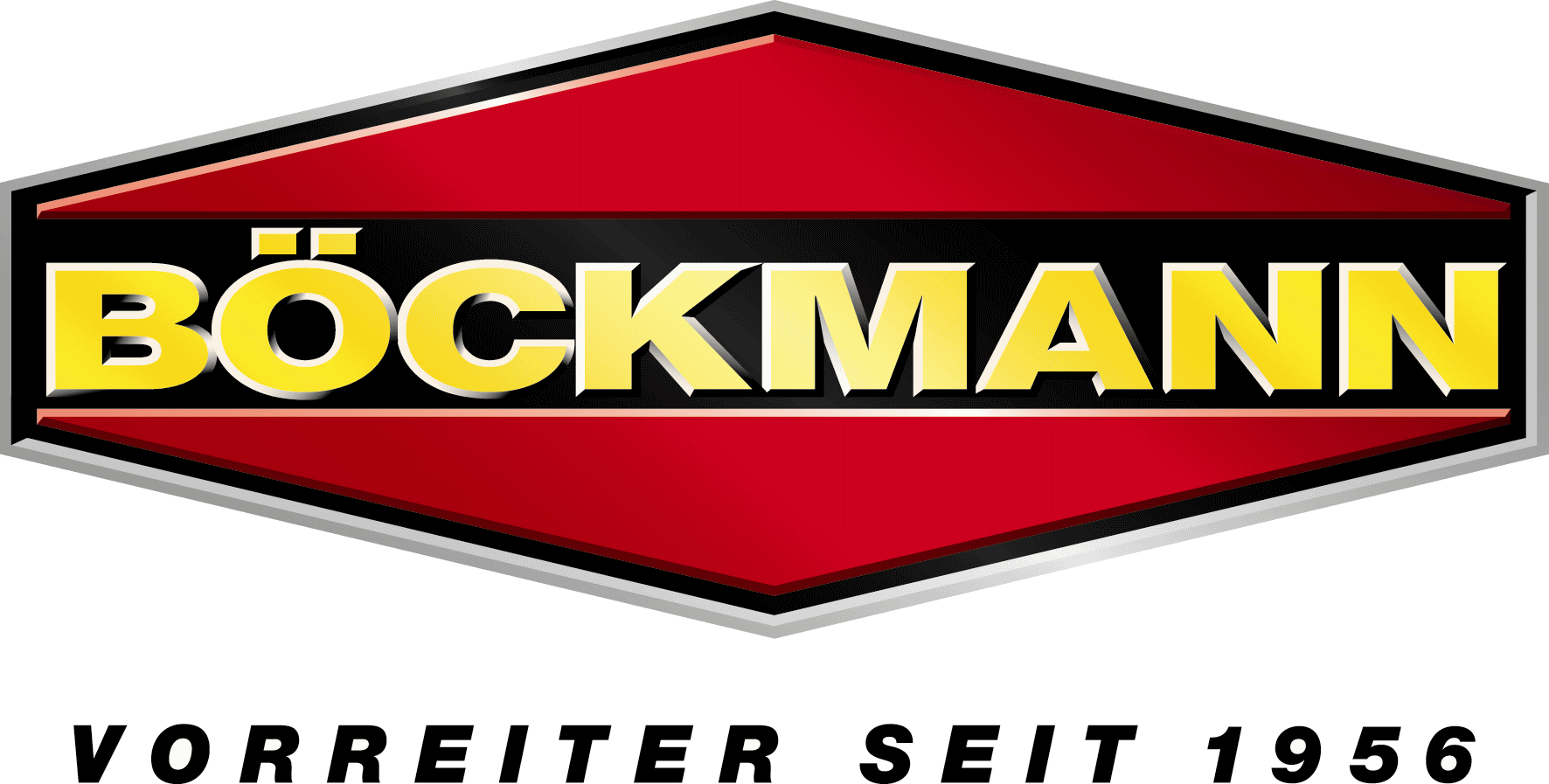
Grand Master SKA with Tack Compartment
Grand Master SR with Full-Height Tack Compartment

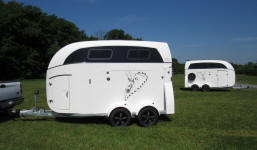
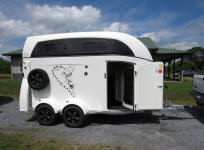
If you’ve read our Böckmann main page, some of the
feature descriptions on this page may seem familiar. But this is newer text
(with more detail in some areas), so if we didn’t make a point clearly
enough on the main page, maybe it will be clearer here. And with that
preamble out of the way…
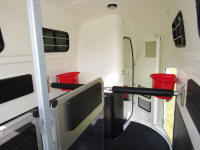

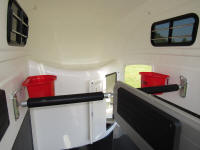
The Grand Master is available as the SKA, with a
well-equipped half-height tack compartment that spans much of the front of
the trailer, and the Grand Master SR, which has a full-height tack
compartment in front of the left stall. That’s the only difference between
them. They’re so similar in fact that they’re identical from the outside.
Most of this writeup consists of text that applies to both models. When we
get to the tack compartments, we’ll specify when a paragraph refers to the
SKA or the SR.
First off, the eye-catching Grand Masters are for horses to 18 hands. With
the adjustable chest & butt bars (a standard feature), they can be set up in
seconds for horses of various sizes. Thanks to a light loaded tongue weight
and aerodynamic shape, the Grand Masters may be pulled safely by many of
today's smaller, more fuel-efficient SUVs, crossovers and trucks. Böckmann
trailers have been in production since the late 1950s and they're sold in
over 30 countries. Even though their designs are advanced, they're also
well-proven in millions of miles of real-world use.
The Grand Masters are loaded with thoughtful features for safety and
convenience and the comfort of your horses.
Let's start with the horse area. With the center post stall divider, you may
swing the front or rear panel of the divider aside for additional working
space. The stall divider and walls are padded and there are kick panels as
well. The stall divider, post and chest & butt bars are easily removed
without tools.
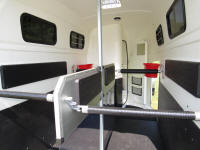
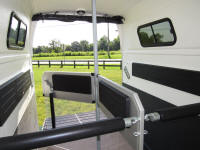
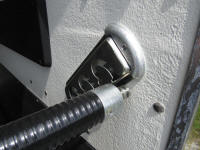
The Grand Masters feature Böckmann's Multi Safe
System (MSS) chest & butt bars, which offer several benefits over the bars
in most trailers. First, MSS bars are quick & easy to use, so the MSS butt
bars let you get out of the kick zone quickly. Second, the MSS bars are
adjustable. There are 2 height adjustments on the chest bars and 3
adjustments on the butt bars. The butt bar mounts are angled, so as you
lower the bar for a smaller horse, it also shortens the stall.
Third, MSS stall bars have an external emergency release capability. The
exterior tie loops serve as the bolts for the chest and butt bar wall
mounts. If a horse gets caught over or under a bar, unscrew the associated
exterior tie loop (using the handle of the standard-equipment lug wrench)
and the wall mount comes down without the need for someone to get in the
trailer with a panicking horse. That's thoughtful design lacking in most
trailers.
And let's add a fourth point - the MSS bars are quiet. If you've heard the
racket the stall hardware makes in a lot of trailers, you and your horses
will appreciate the interior calm of a Böckmann.
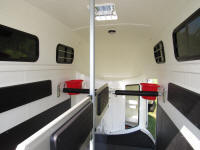
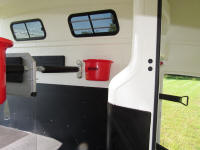
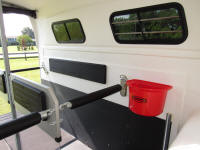
The Grand Masters have two sliding windows on each
side. In addition, there's a roof vent/skylight and the self-furling rear
curtain is so easy to use that most folks run with it up. This combination
makes for a bright, inviting and well-ventilated interior. Body height is
big-horse friendly at 7'6"+.
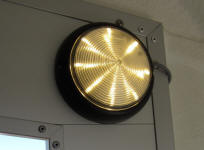
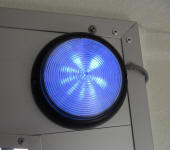
The Grand Masters come with hay bag loops and
flat-backed feed buckets (which have their own wall mounts), so there's
plenty to keep the horses occupied while aboard. Another thoughtful feature
on Böckmann trailers is their 2-color interior lights. Flip the switch one
way for human-friendly white LED light. Flip the switch the other way for
horse-calming blue light.
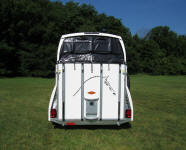
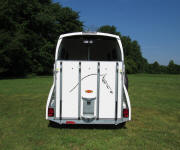
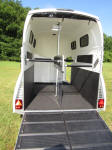
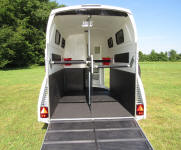
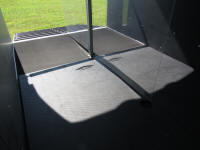
As with most Böckmann trailers, the Grand Masters
have a 5' tall ramp for a more comfortable incline than the more common 4'
ramps. The ramp mat has molded toeholds and there's lift assist in the form
of a pair of gas springs. Unlike the torsion springs that provide less
assist as a ramp goes up, gas springs provide consistent force over the
ramp's entire travel. And one more feature on the ramp - in case you're
wondering how to reach that self-furling rear curtain, look closely at the
license plate holder and you'll see a curved step below the tag location and
another step above it.
Here's another feature the humans can appreciate - The Grand Master's mat is
bonded to the floor and the edges are sealed. Horse wastes don't reach the
structural floor and clean up after a trip is a breeze. Just sweep or hose
it out. No need to lift mats. Grand Master models come with an extra layer
of mat under the horses' front feet.
Since we mentioned the structural floor, we should tell you what it is. The
structural floor consists of transverse extruded aluminum panels, with extra
reinforcement in the high load areas. The chassis consists of
corrosion-protected galvanized steel and the Grand Master's body is of
fiberglass. Fiberglass has been the material of choice in the boating
industry since the early 1960s, so it has proven its worth in hard use.
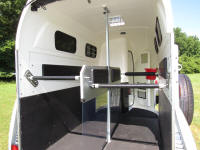
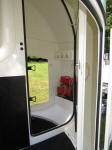
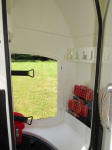
Let's move on to the Grand Master SR’s (aka “GM SR”
or just “SR”) tack compartment. As mentioned earlier, it’s a full height
compartment in front of the left stall. Easily access your saddles and tack
through the exterior door on the left side of the nose. But if you're inside
the trailer, no need to walk all the way around. There's a standing-height
tack door inside the trailer. And while we're talking doors, there's a groom
door in front of the right stall. In the GM SR, at the right stall, head
space is over 6 feet from the chest bars to the front wall. Even with the
full-height tack compartment, there's about 3 feet of head space forward of
the SR’s left stall.

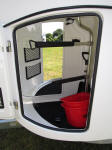
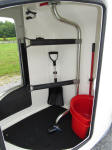
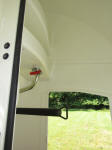
The Grand Master SR's full-height tack compartment
is much larger than you'll typically find in a European trailer. There are
two telescoping saddle racks on an offset post. Rotate the post and extend
the racks to easily access your saddles while standing next to the trailer.
There are two shelves above the saddle racks and another two shelves along
the front wall of the compartment. On the back wall are a telescoping
shovel, a telescoping broom and a 5-place whip holder. Down low near the
whip holder is a releasable elastic strap to secure small items in the rear
corner.
At the front of the SR’s tack compartment, there are 4 bridle hooks on the
front face of one of the shelves. You may have noticed the red and black
things in one of those shelves - those are the two folding stools/steps in 2
different heights (they're a standard feature on the Grand Masters). On the
exterior door, there are two storage nets, a mirror and a tack hook. On the
interior door is another mirror, another tack hook and a third storage net.
To save you some math, that’s 6 tack hooks, 3 storage nets and 2 mirrors in
the GM SR.
Now for the Grand Master SKA’s (aka “GM SKA” or “SKA”) tack compartment…
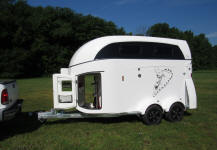

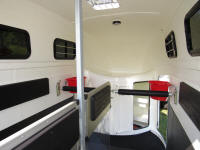
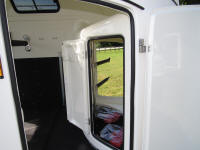
As with the GM SR, saddles and tack are easily
accessed through the exterior door on the left side of the SKA’s nose.
There’s an interior tack door as well, in front of the right stall.
Completing the door arrangement, there’s a groom door in front of front of
the right stall, right next to the tack door. It’s an easy reach.
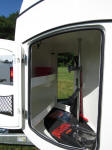
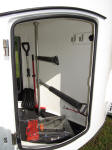
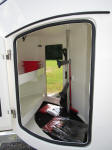
Böckmann fits a surprising number of useful features
in the SKA’s tack compartment. There are two telescoping saddle racks and on
the back wall, there are 2 bridle hooks, a 5-place whip holder, a
telescoping shovel and a telescoping broom. There are two deep shelves along
the front wall of the compartment. In one of the shelves, there's a recess
for stowing those feed buckets we mentioned earlier. On the exterior door,
there's a storage net, a mirror and a tack hook. On the interior door,
there's another pair of tack hooks, giving a total of 5 hooks in the SKA
There's also a pair of removable elastic straps for securing or hanging
light items.
Standard accessories with the Grand Masters and other models include a lug
wrench, wheel chocks, a hitch ball cover (it's recommended that you keep
grease on the ball) and an anti-theft "ball" that you pop into the coupler.
Böckmann trailers have an integrated coupler lock. Pop that dark blue ball
into the coupler, turn the key and it's locked into the coupler so a
ne'er-do-well can't just hook up and drive off.
Here's yet another Böckmann thoughtful feature - a status indicator on the
side of the coupler. The status indicator pointer will be in the blue zone
if the coupler is properly secured on the ball. If someone tries to put it
on a ball that's too small, the indicator will be in the red minus zone. If
the coupler isn't connected properly, the pointer will be in the red "X"
zone.
The thing that initially draws many trailer shoppers to Böckmann trailers is
their ease of towing. Böckmann trailers may be towed safely by many of
today's smaller and more fuel-efficient SUVs, crossovers and trucks. The
rule of thumb for domestically-produced horse trailers is that they carry
10-15% of their load on the hitch, which results in a loaded tongue weight
in the 600-800 lb. range. By comparison, a Böckmann carries only 3.75% of
its load on the hitch.
The Grand Master has a Gross Vehicle Weight Rating of 2700 kilograms, or
about 5950 lbs., so even loaded to the maximum, 3.75% of 5950 works out to a
loaded tongue weight of about 223 lbs. And to reiterate, that's when the
trailer is loaded to the maximum. Most folks don't run with a trailer loaded
to the maximum. Thanks to that light tongue weight, many folks who pull a
Böckmann for the first time comment that there's little sensation that
they're pulling a trailer.
Most horse trailers built in North America have electric brakes, which
require you to have a brake controller in the tow vehicle. And many brake
controllers need to be adjusted as the load in the trailer changes. With the
Grand Master's inertia-actuated mechanical brakes, life is much simpler. The
brakes apply braking force automatically in proportion to the load in the
trailer. You don't need to fiddle with a brake controller. In fact, you
don't even need a brake controller!
Here's a simple description of how Böckmann’s mechanical brakes work: As you
slow your tow vehicle, the trailer's coupler assembly compresses slightly,
pulling a rod, which pulls a short cable to each brake drum. (The cables
allow the wheels to move up and down without interfering with brake
operation.) The empty trailer compresses the coupler assembly with a certain
amount of force. Load one horse and there's now the weight of the trailer
plus 1000 lbs. or so of horse to compress the coupler assembly with more
force, producing more braking force. Load a second horse and now it's the
weight of the trailer plus 2000 lbs. or so compressing the coupler assembly
to produce proportionately more braking force. While electric brakes are
common here in the States, in most countries, mechanical trailer braking
systems as on a Böckmann have been the predominant design for decades.
They're simple, safe and reliable. No electronics to fail, no brake fluid to
change, no brake lines to rust out.

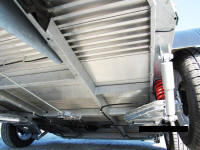
But wait, there's more... Grand Master models ride
on Böckmann's WCFPlus® coil spring suspension. Nicer domestically-produced
horse trailers ride on torsion axles. Torsion axles are fine, as Böckmann
puts them on their smaller models, but a coil spring suspension (with shock
absorbers) provides an even smoother ride. If you like the ride of your
motor vehicle, take a peek behind one of the wheels and you'll likely see
it's riding on coil springs. As you'd expect, the Grand Masters ride on
radial tires and as you might not expect, they come with aluminum alloy
wheels as standard (including spare). Wheel bearings are sealed, eliminating
the annual task of packing bearings with grease recommended by most trailer
manufacturers.
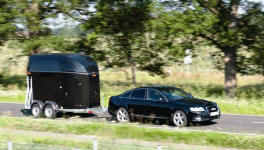
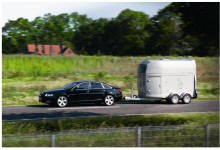
A little earlier, we commented on a Böckmann's ease
of towing. It's very easy to connect and disconnect and the ramp and stall
hardware are easy to use, but it's also easy on the vehicle. Thanks to the
light tongue weight and aerodynamic shape, a Böckmann can be towed safely by
smaller-than-typical tow vehicles. (Above are a couple of factory-provided
photos. Those are older models, but we like those photos because they show
that in many countries, the tow vehicle is a car.) Here are Böckmann's tow
vehicle minimum requirements:
The tow vehicle must:
1. Have at least 125 horsepower. Here in the States, most folks pull a
Böckmann with a smaller SUV or truck with 6-cylinder or turbocharged
4-cylinder engine. These typically have well over 200 HP, so the horsepower
requirement is easily met.
2. If truck or SUV (meaning a vehicle with a higher center of gravity than a
car), must have a wheelbase of at least 100 inches. These days, even a
compact sedan often has a wheelbase in the 105" range. We're not suggesting
you tow with a compact sedan, but we use this example to emphasize that the
vehicle doesn't have to be huge to meet the 100" wheelbase minimum. (Since
we brought up the subject, compact sedans often meet or exceed Böckmann’s
minimum horsepower requirement as well, but most are rated for little or no
trailer hitch weight.)
3, Must be able to handle the trailer's maximum tongue weight. As calculated
earlier, even loaded to the maximum a Grand Master’s tongue weight is only
about 223 lbs. Even smaller SUVs are often rated to handle at least 300 lbs.
tongue weight. As mentioned earlier, the tongue weight for a
domestically-produced horse trailer is typically in the 600-800 lb. range. A
Böckmann puts far less load on the tow vehicle's rear suspension for a
smoother ride. And the vehicle remains more level for more predictable
handling. If you're not sure what tongue weight your vehicle is rated for,
the information is often in a towing section in the vehicle's owner's
manual. Quite often, the maximum tongue weight will be 10% of the tow
capacity rating. For instance, if they've assigned a tow capacity of 5000
lbs., more often than not, the vehicle will be rated to handle 500 lbs.
tongue weight. (But please note, this is just a guideline. Rely only on the
official number in your owner's manual or from the vehicle manufacturer.)
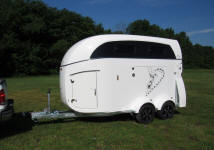
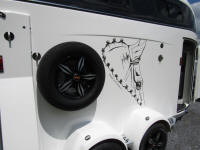
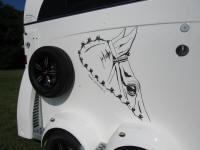
The only option ordered on the trailers shown here
is the large "Competition" graphic. Everything else you see here is standard
on the Grand Masters.
(Please note that the blue & white light and suspension pictures are detail
shots we took of Portax models, but the details of the lights, suspension
components and underside of the floor are representative of the same
components on the Grand Masters. In those suspension shots, the black
rectangles are where we blotted out the photo date stamps.
